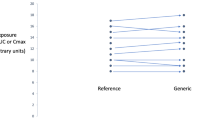Summary
Therapeutic inequivalence may be defined as the absence of therapeutic equivalence when equivalence is expected. Generic drugs are regulated in the USA as follows: drugs which are copies of pre-1938 innovator drugs have no requirement for approval before marketing, whereas a major requirement for regulatory approval with generics of post-1938 innovator drugs is that their bioequivalence with the innovator drug must be demonstrated. Specifically, the generic drug is considered bioequivalent if its rate and extent of absorption are not significantly different (± 20%) from those of the innovator drug when administered under similar experimental conditions.
In terms of risk-benefit assessment, the generic should be therapeutically equivalent to the innovator but less expensive. Therefore, the aim of generic drug regulation should be to minimise therapeutic inequivalence at a cost that does not obviate the economic benefits of generics. Regardless of the safety considerations with the innovator drug, there is always a small but finite additional risk of therapeutic inequivalence when switching from innovator to generic, or from one generic to another. To date, there is no evidence of therapeutic inequivalence in a properly manufactured generic drug which has been approved as bioequivalent by the FDA. Therapeutic inequivalence is more easily detectable in institutions than by individual physicians who may ascribe the symptoms of therapeutic failure to a worsening of the underlying disease of the patient.
Guidelines and suggestions for the regulation of generic products include the following: making drugs easily identifiable in terms of manufacturer and active ingredients, retaining samples of tested bioequivalence specimens by health authorities, random testing of generic products, introducing separate regulatory requirements for bulk suppliers and new regulations for older (pre-1938) products, designating institutions for reporting adverse drug reactions and therapeutic failure with generics, and educating health care professionals on the differences between generics and innovators, so as to avoid therapeutic failure and/or adverse reactions.
Similar content being viewed by others
References
Editorial. Editors and Auditors. Journal of the American Medical Association 261: 2543–2545, 1989
Grubb BP. Recurrence of ventricular tachycardia after conversion from proprietary to generic procainamide. American Journal of Cardiology 63: 1532–1533, 1989
Wyllie E, Pippenger CE, Rothner D. Increased seizure frequency with generic primidone. Journal of the American Medical Association 258: 1216–1217, 1987
Author information
Authors and Affiliations
Rights and permissions
About this article
Cite this article
Rheinstein, P.H. Therapeutic Inequivalence. Drug-Safety 5 (Suppl 1), 114–119 (1990). https://doi.org/10.2165/00002018-199000051-00018
Published:
Issue Date:
DOI: https://doi.org/10.2165/00002018-199000051-00018



